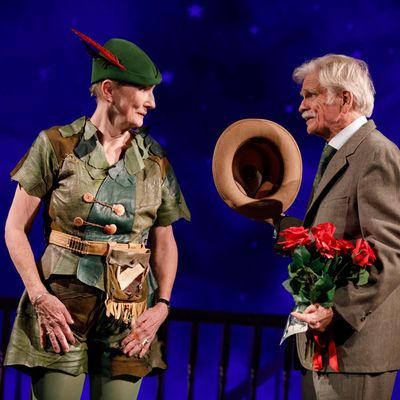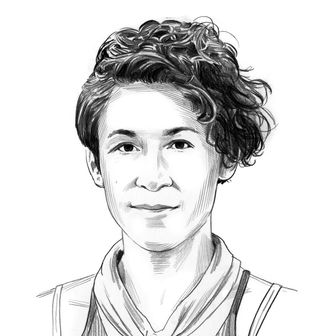
I hope it’s not giving too much away to say that the final image in Sarah Ruhl’s For Peter Pan on her 70th birthday, directed by Les Waters at Playwrights Horizons, is, literally and figuratively, an uplifting one. But ever since witnessing it, I’ve been fighting a sinking feeling. Why did a play that so clearly aims to give its audience a sense of bittersweet transcendence instead feel a bit sour? What had happened between an inspired idea — the painful and lovely image of Peter Pan, Wendy, and the gang embodied by actors well beyond the age limit for Neverland — and a production that left me more frustrated than inspired?
It’s all the more puzzling, because I’ve long admired Ruhl’s work. Her combination of midwestern frankness with a poet’s affection for verbal musicality and crystalline, mathematical structure has given us a wry, haunting take on the Orpheus myth (Eurydice); an epic examination of faith and theater across three different time periods (Passion Play); and an off-kilter adventure about what happens when you start answering a Dead Man’s Cell Phone — among other sparklingly imaginative works.
So as I read her playwright’s note in the program before the curtain rose, I was intrigued and excited. She describes the deeply personal origins of For Peter Pan, her most autobiographical work to date, which she wrote as a gift for her mother’s (yes) 70th birthday. (Kathleen Ruhl played Peter Pan as a teenager at the Children’s Theatre in Davenport, Iowa. The round-faced redhead, aloft in her green tights on the cover of For Peter Pan’s program, is Mom.) After her childhood theatrical triumph, Ruhl’s mother went on to earn a Ph.D. in rhetoric, give birth to two daughters, and lose first her husband (at only 52) and then both her parents to cancer. That’s also the backstory that Ruhl provides for her protagonist, Ann (played by Kathleen Chalfant, in a performance both grounded and wistful).
Ann is the oldest of five siblings who are drawn from life — drawn, in fact, from Ruhl’s own family. Though the characters are “composite and fictional,” the playwright conducted interviews with her relatives in Iowa to create them. In the play’s second part, we hear selections from these interviews verbatim, in all their overlapping conversational candor. “I wondered,” Ruhl explains, “if it was possible to write a play about one’s family with love, a play they might want to come see.”
She has set herself the challenge of portraying a basically caring and functional family — no easy task, as Tolstoy (“all happy families are alike”) noted. Yes, Ruhl’s onstage family bickers, but it never erupts into the toxic geyser of secrets, skeletons, and betrayals that we’ve come to expect from the likes of August: Osage County. Drama, the maxim goes, is born of conflict, a very Western (and, some would argue, very male) notion, and 99 percent of the narrative content we consume adheres to it. So it’s exciting to see Ruhl exploring a different path. She describes her play as a “Midwestern Noh drama,” in which “the protagonist meets the ghost, then recognizes the ghost, then dances with or embraces the ghost.”
In Ruhl’s three-act play, we meet Ann and her four siblings in a hospital room, keeping vigil around their dying father. In the second act, we watch them drink Jameson and argue politics at his wake, as the father who lay in bed dying in part one (Ron Crawford) shuffles among them unseen, an indifferent specter quietly reading the paper, putting NutraSweet on his grapefruit, and feeding Chex mix to the family dog (also dead, though not as recently). Part three is a kind of fantasia in which the aging siblings don the costumes and attitudes of an enthusiastic children’s theater production of Peter Pan and, led by Ann as Peter, make one last attempt to fly, visit Neverland, and do battle against the inevitable reality of growing up.
So far, so fascinating. Why, then, did I leave the theater feeling that this production sometimes took flight but sometimes — to borrow Ann’s remembrance of the rickety flying apparatus from her childhood play — “sort of dragged across the floor?” It comes down to two things: design and politics.
First, design. Or, in the case of this production, overdesign. Some playwrights create worlds that beg to be stuffed to the brim. But Ruhl’s plays don’t take place in solid settings — even when they do, they don’t. Her plays are more like mind palaces or dreamscapes, in which the stage directions might call for a school of enormous flying fish, or for a character to ride on an ascending planet or turn into an almond. To her credit, she always makes room for the imagination of those bringing her work to life. On the first page of the script of For Peter Pan she writes, “If there is no actual flying, one can imagine beautiful painted backdrops that make you think the actors are flying.”
As a child of community theater, Ruhl appreciates the magic that can be made out of next to nothing: an empty space, a simple backdrop, a fantastical image, an inventive gesture. But now her work is being produced in big spaces with lots of resources — which means that all too often directors and designers opt for the literally embodied manifestation rather than the brilliantly imaginative suggestion. These days, in response to a stage direction like “the set contains a raining elevator” (from Ruhl’s Eurydice), theaters on the scale of Playwrights Horizons are likely to provide, well, a raining elevator.
That’s one particular kind of magic, but there’s another, sparer kind that I found myself longing for as I watched For Peter Pan. Ruhl herself, in her description of the play’s settings in her script, repeatedly calls for “an empty space” (with a little bit of decoration — a chair here, a curtain there). But on the stage at Playwrights Horizons, there’s no empty space to be seen.
Instead, we see a fully kitted-out hospital bed, bristling with tubes and plugs and machines; a number of big, solid walls; and, in the background, the towering façade of a white midwestern house, complete with porch and hedgerow. The house’s façade even moves around in Act Three to create the scene of a nursery interior. Such a solid, engineered, and, in parts, literal space seems to me to weigh down Ruhl’s play. Her creations are like soufflés, which is no insult. They’re delicate, tricky concoctions by a master baker. You can’t build a house on top of a soufflé, which is what Les Waters and scenic designer David Zinn have done. Ruhl revels in the world of fancy, but this production’s visuals leave little to the imagination. When Ann-as-Peter finally takes flight, the moment should astonish us. But when we’ve spent 80 minutes staring at a set as heavily (and expensively) laden as Zinn’s, we’re beyond surprise at seeing an actor moved up and down on a few wires. Our brains get ahead of our hearts and cut them off at the pass.
If the scenic design dampens the potential power of the play’s magical side, then it’s handling of politics puts a kink in its realistic side — its grown-up side, if you will. This is due to a tricky wrinkle in time that I’m not entirely sure can be ironed out: When not in Neverland, For Peter Pan takes place during the Clinton years, and the original production was staged in the spring of 2016. Today, both of those eras feel like a galaxy far, far away.This is bad luck for Ruhl and Waters. Like pretty much every artist in America right now, they’re stuck trying to figure out how the hell to make art in the age of Trump — and the inconvenient truth is that they might suddenly have a period piece on their hands, both in terms of when the play is set and when it was written.
Right now, the play’s engagement with politics feels preemptively dated: The three brothers are Reagan Republicans, Ann is the token artsy liberal who cares too much and will eventually get upset by the conversation, and the youngest sibling, Wendy (the touchingly nervy Lisa Emery), is a bundle of irritated avoidance. In Act Two, as the whisky begins to flow, the men spout clichés about liberals living “in unreal worlds” while “conservatives are pragmatists who try to solve problems on the ground.” They even throw in the age-old joke (attributing it to their dad): “If you’re not a liberal before the age of 20 you have no heart, and if you’re not a conservative after the age of 40 you have no brain.” On one hand, Ruhl has deftly transcribed a certain kind of conversation that goes on in her family. On the other hand, the old jokes and the old arguments struck me as not only tired but not quite harmless anymore, even when delivered by a bunch of very nice Midwesterners. The ensemble of siblings — which is rounded out by Daniel Jenkins as the kindly, pragmatic John, and Keith Reddin as the chipper, bespectacled Michael, and David Chandler as the overbearing but exasperatingly likable Jim — play together with an easy, affectionate familiarity. They handle Ruhl’s rhythms expertly, but something in the notes feels a little off.
In the first act, as Ann sits in her father’s hospital room, searching for an answer in a crossword puzzle, she says to her siblings, “To move laterally… eight letters—anyone?” A few lines later, she triumphantly exclaims, “Sidestep!” It’s a pointed moment. While Ruhl is a writer of great dexterity, I often felt like her play was stepping right up to some difficult subject only to dance lightly away from it, glancing off its surface so that we could see ripples of the thing—politics, religion, death (mostly death)—without experiencing it full force. This is her way, and it’s no good asking her to attack when she explicitly tells us she’s going to evade. But the risk in such an approach is that it can start to feel coyly sentimental, and that’s what’s happening periodically in For Peter Pan. Too much NutraSweet, not enough grapefruit.
Especially in the play’s final moments, I found myself longing for a little less heartwarming spirituality and a little more bite. As Ann smiled and embraced her father’s ghost — who has just brought her roses and assured her “I’ve been here all along” — then turned to us and lovingly described the theater as a place “where you don’t have to grow up,” I knew my spirits were supposed to lift toward the rafters along with Peter Pan. But my heart felt stuck, grounded. And as I left the theater I couldn’t help but wonder whether For Peter Pan might have soared more freely if it had taken more of an emotional leap — if it had refrained from sentimental consolation and instead embraced a, well, more grown-up willingness to face mortality and loss. Ruhl’s play is standing right on the edge of something quite marvelous and mournful, but at times it feels just a little too afraid of its own shadow.
For Peter Pan on her 70th birthday is at Playwrights Horizons.





